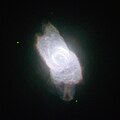Dosya:NGC 6572.jpg
NGC_6572.jpg (500 × 500 pikselan, ebatê dosya: 135 KB, MIME tipê cı: image/jpeg)
Verêniya dosya
Seba diyayışê viyarteyê dosya ra tarixê ke qısımê tarix/zemani derê inan bıtıkne.
| Tarix/Zeman | Resımo qıckek | Ebadi | Karber | Mışewre | |
|---|---|---|---|---|---|
| nıkayên | 17:08, 14 Kanun 2010 |  | 500 - 500 (135 KB) | Antonsusi | Better jpg-quality, less environment of no interest |
| 14:59, 13 Kanun 2010 |  | 629 - 638 (68 KB) | Jmencisom | {{Information |Description={{en|1=The NASA/ESA Hubble Space Telescope has turned its eagle eye to the planetary nebula NGC 6572, a very bright example of these strange but beautiful objects. Planetary nebulae are created during the late stages of the evol |
Gurenayışê dosya
The following pages link to this file:
Gurenayışê dosyaya gılovere
Ena dosya wikiyanê binan de gureniyena.
- ar.wikipedia.org sero guriyayış
- az.wikipedia.org sero guriyayış
- be.wikipedia.org sero guriyayış
- ce.wikipedia.org sero guriyayış
- cs.wikipedia.org sero guriyayış
- de.wikipedia.org sero guriyayış
- en.wikipedia.org sero guriyayış
- fa.wikipedia.org sero guriyayış
- fr.wikipedia.org sero guriyayış
- hr.wikipedia.org sero guriyayış
- it.wikipedia.org sero guriyayış
- it.wikibooks.org sero guriyayış
- kk.wikipedia.org sero guriyayış
- mk.wikipedia.org sero guriyayış
- nl.wikipedia.org sero guriyayış
- pl.wikipedia.org sero guriyayış
- pt.wikipedia.org sero guriyayış
- ru.wikipedia.org sero guriyayış
- sk.wikipedia.org sero guriyayış
- tr.wikipedia.org sero guriyayış
- tt.wikipedia.org sero guriyayış
- www.wikidata.org sero guriyayış
- zh.wikipedia.org sero guriyayış


